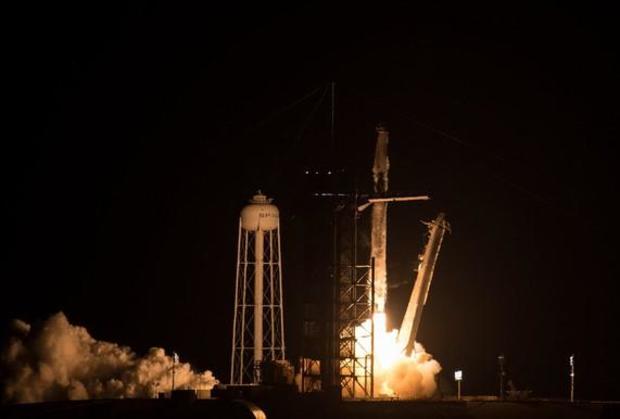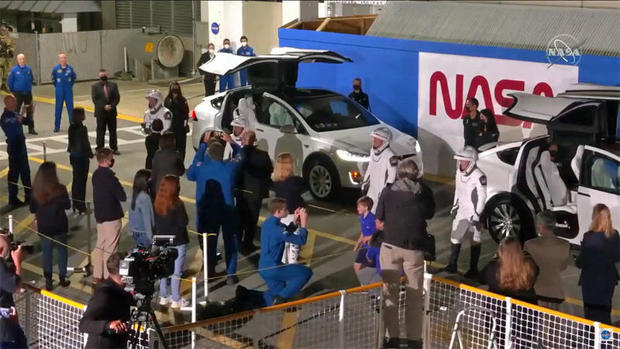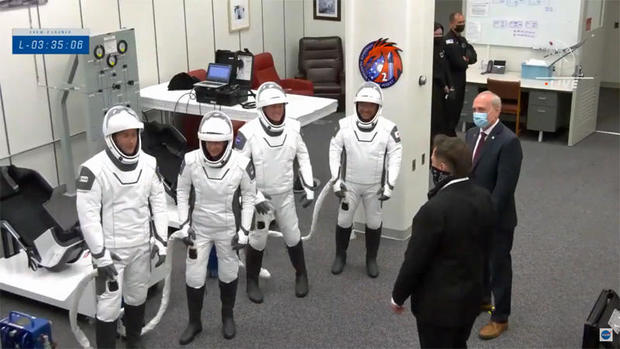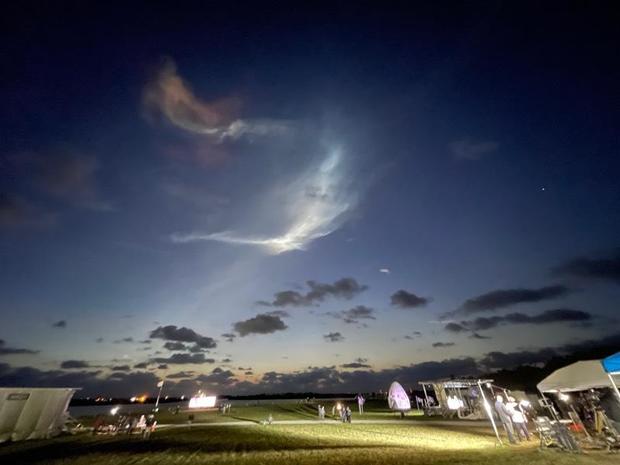Lighting up the pre-dawn sky, a Falcon 9 rocket with a previously flown first stage roared to life and shot away up the East Coast early Friday, boosting a refurbished SpaceX Crew Dragon capsule into orbit carrying four astronauts on a day-long trip to the International Space Station.
Running 24 hours late because of threatening off-shore weather, the rocket’s nine first stage engines ignited at 5:49 a.m. EDT, throttled up to a combined 1.7 million pounds of thrust and smoothly pushed the slender booster away from historic pad 39A at the Kennedy Space Center.
Strapped in four abreast, commander Shane Kimbrough, co-pilot Megan McArthur, Frenchman Thomas Pesquet and Japanese astronaut Akihiko Hoshide, all space veterans making their first flights aboard a SpaceX capsule, monitored the automated ascent on large touch-screen displays.
The launching provided a spectacular pre-dawn show for area residents and tourists as the Falcon 9 climbed skyward, shattering the morning calm along Florida’s “Space Coast” with a thunderous wall of sound as the booster streaked away to the northeast over the Atlantic Ocean atop a sky-lighting jet of flame.
Two-and-a-half minutes after liftoff, the first stage engines shut down, the booster fell away and the single vacuum-rated Merlin engine powering the second stage took over, continuing the climb to orbit.
The first stage, meanwhile, flipped around and headed for landing on an off-shore droneship, touching down nine-and-a-half minutes after takeoff to chalk up the company’s 80th successful stage recovery, its 58th at sea.
Two-and-a-half minutes after that, the Crew Dragon was released from the second stage to set off after the space station. Docking is expected at 5:10 a.m. Saturday.
The launching marked only the third piloted flight to orbit from U.S. soil since the shuttle’s retirement in 2011 and the second operational Crew Dragon mission, a flight known simply as “Crew-2,” as NASA transitions away from its post-shuttle, sole reliance on Russian Soyuz spacecraft.
And in a first for NASA’s commercial crew program, the Crew-2 astronauts rode into orbit atop a Falcon 9 rocket with a previously flown first stage, strapped into a Crew Dragon making its second flight.
The capsule first flew last May, carrying Douglas Hurley and Robert Behnken — McArthur’s husband — into orbit in the program’s first and only piloted test flight. The second piloted flight, which blasted off last Nov. 15, carried four astronauts to the space station for SpaceX’s first operational Crew Dragon mission.
SpaceX initially planned to use all new rockets and capsules for commercial astronaut flights, but last year the company asked NASA to consider flying previously flown vehicles and, after a detailed review, the agency agreed.
“Over the last year or so, we have worked on reuse (issues),” said Steve Stich, manager of NASA’s commercial crew program. “This is the vehicle that Bob and Doug flew, and we’ll have our first reused booster. We’ve worked through that certification effort … and we’re in really good shape on reuse.”
During its refurbishment, the capsule was structurally beefed up to make it better able to withstand the forces imparted during windy weather splashdowns in rough seas, somewhat easing strict landing weather constraints. The spacecraft’s abort system was upgraded, enabling on-pad emergency escape in higher winds, new parachutes were installed and a new heat shield was attached.
All four crew members said they were comfortable flying aboard a “used” spacecraft for the first time since the shuttle program ended. Not surprising, perhaps, given SpaceX had re-flown 59 first stage boosters going into Friday’s launch, one of which has nine flights to its credit. Two others have flown eight times.
McArthur is a veteran space shuttle astronaut who helped service the Hubble Space Telescope. When she found out she would be strapping into the same Crew Dragon that carried her husband to and from the space station last year, “I was thrilled and surprised. It’s kind of a neat twist on the whole story.”
As for their young son and the question of risk, McArthur said, “it’s always hard to know exactly what a child absorbs (but) his understanding of it has evolved over time.”
“He recently saw his father launch and then stay on the International Space Station for two months. And now it’s mom’s turn, and I’m going to be gone for six months. So it really has been a build-up approach. And when he talks about it, he talks about well, he’s going to go next. But he’s going to go to (the Transformers’ home planet) Cybertron. So he’s got big goals as well!”
Behnken and the couple’s son, Theo, were on hand for launch Friday, bidding McArthur a warm farewell before the crew was driven to the launch pad in white Tesla SUVs.
With a picture-perfect launch, the Crew Dragon astronauts planned to monitor the initial stages of the spacecraft’s automated rendezvous with the space station, calling it a day at 2 p.m. Wakeup was expected late Friday to prepare for docking with the space station early Saturday.
They will be welcomed aboard by space station commander Shannon Walker and fellow Crew-1 astronauts Michael Hopkins, Victor Glover and Japanese astronaut Soichi Noguchi, along with Soyuz MS-18/64S commander Oleg Novitskiy, Pyotr Dubrov and NASA astronaut Mark Vande Hei.
The Soyuz crew arrived on April 9, docking at the station three hours after launch from the Baikonur Cosmodrome in Kazakhstan. They replaced Soyuz MS-17/63S commander Sergey Ryzhikov, Sergey Kud-Sverchkov and NASA astronaut Kate Rubins, who undocked and returned to Earth April 17 to close out a 185-day stay in space.
The arrival of the Crew-2 astronauts will briefly boost the lab’s crew from seven to 11. But after a four-day handover, Hopkins, Glover, Walker and Noguchi will undock and return to Earth in their own Crew Dragon, splashing down in the Gulf of Mexico south of Tallahassee, Florida, around 12:40 p.m. Wednesday to close out a 164-day mission.
Before the Soyuz crew departed, Ryzhikov turned over command of the space station to Walker. The day before her departure, Walker plans to turn the complex over to Hoshide.
The Japanese astronaut originally was scheduled for launch aboard a Russian Soyuz last year, when the Tokyo Olympics were scheduled for 2020. But Hoshide was bumped from the Soyuz crew when NASA decided to launch astronaut Chris Cassidy in his place to avoid a possible gap in U.S. station crews.
As it turned out, the Olympics were delayed to this summer by the COVID pandemic, and Hoshide’s assignment to the Crew-2 mission ensures a Japanese commander in orbit when the games begin, assuming COVID concerns do not trigger another delay.
“If I (am) up there for the Olympic Games, that would be great, it’d be awesome to watch it and cheer for the all the teams from different countries from space station, especially since it’s the Tokyo Olympics,” he said. “We slip, they slipped, hopefully we align again. But either way is fine with me.”
The Crew-1 capsule’s landing will mark only the second time returning astronauts have returned to an ocean splashdown since NASA’s Apollo-Soyuz Test Project crew came home in 1975.
As with SpaceX’s initial Demo-2 test flight last August, the company will have a recovery ship standing by to secure the spacecraft and help the crew get out as the astronauts begin readjusting to the unfamiliar tug of gravity after nearly six months in weightlessness. After initial medical checks, they will be flown to shore by helicopter and handed off to NASA.
When the Demo-2 crew splashed down south of Pensacola last Aug. 2, NASA and SpaceX recovery crews were surprised by numerous pleasure boaters enjoying a sunny day in the Gulf who quickly surrounded the capsule, snapping cell phone photos, waving flags and, in some cases, beer cans.
This time around, the Coast Guard is expected to patrol a 10-nautical-mile-wide safety zone to prevent interference and to keep the public away from any potential exposure to toxic propellants.
With the Crew-1 splashdown, NASA and Roscosmos, the Russian space agency, will have swapped out the space station’s entire seven-member crew in just three weeks, replacing two Russians, four Americans and a Japanese flier with two more cosmonauts, three NASA astronauts, another Japanese flier and a European Space Agency astronaut. All are veteran except Dubrov, who is making his first flight.
All seven crew members face a particularly busy six months in space with multiple U.S. and Russian spacewalks planned, the arrival of four cargo ships loaded with science gear, crew supplies, spare parts and new roll-out solar array blankets needed to boost the lab’s power.
Four NASA-planned spacewalks will be needed to install two sets of IROSA solar blankets and two Russian EVAs are planned to make connections between the station and a new Russian laboratory module that’s scheduled for launch in mid July atop a powerful Proton rocket.
To make way for the new laboratory compartment, the cosmonaut crew plans to jettison the station’s Pirs docking and airlock compartment, using an attached Progress supply ship to drive it back into the atmosphere. After the lab module is docked in place of Pirs, Novitskiy, Dubrov and Vande Hei will strap into their Soyuz and fly it to docking at a port on the newly-arrived lab.
The Crew-2 astronauts and the Soyuz MS-18/64S crew will return to Earth in late September and mid October respectively.





